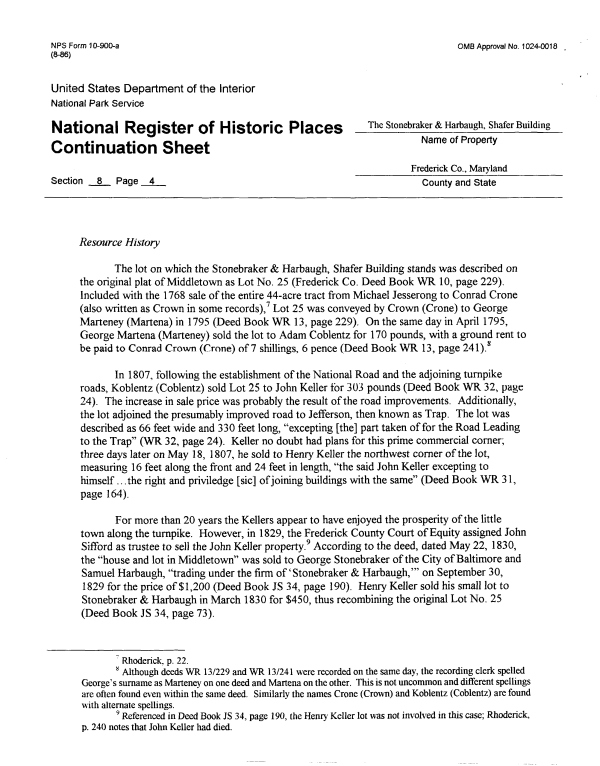 |
||||
|
DEPARTMENT OF HOUSING AND COMMUNITY DEVELOPMENT, MARYLAND HISTORICAL TRUST (Historic Sites Survey) var.d. MSA SE16-6 Image No: se16-6-0269 Enlarge and print image (67K) |
 |
||||
|
DEPARTMENT OF HOUSING AND COMMUNITY DEVELOPMENT, MARYLAND HISTORICAL TRUST (Historic Sites Survey) var.d. MSA SE16-6 Image No: se16-6-0269 Enlarge and print image (67K) |
| NFS Form 1 0-900-a (8-86) OMB Approval No. 1 024-001 8 United States Department of the Interior National Park Service National Register of Historic Continuation Sheet Section 8 Page 4 The Stonebraker & Harbaugh, Shafer Building Name of Property ______Frederick Co., Maryland______ County and State Resource History The lot on which the Stonebraker & Harbaugh, Shafer Building stands was described on the original plat of Middletown as Lot No. 25 (Frederick Co. Deed Book WR 10, page 229). Included with the 1768 sale of the entire 44-acre tract from Michael Jesserong to Conrad Crone (also written as Crown in some records),7 Lot 25 was conveyed by Crown (Crone) to George Marteney (Martena) in 1795 (Deed Book WR 13, page 229). On the same day in April 1795, George Martena (Marteney) sold the lot to Adam Coblentz for 170 pounds, with a ground rent to be paid to Conrad Crown (Crone) of 7 shillings, 6 pence (Deed Book WR 13, page 241).8 In 1807, following the establishment of the National Road and the adjoining turnpike roads, Koblentz (Coblentz) sold Lot 25 to John Keller for 303 pounds (Deed Book WR 32, page 24). The increase in sale price was probably the result of the road improvements. Additionally, the lot adjoined the presumably improved road to Jefferson, then known as Trap. The lot was described as 66 feet wide and 330 feet long, "excepting [the] part taken offer the Road Leading to the Trap" (WR 32, page 24). Keller no doubt had plans for this prime commercial corner; three days later on May 18, 1807, he sold to Henry Keller the northwest corner of the lot, measuring 16 feet along the front and 24 feet in length, "the said John Keller excepting to himself.. .the right and priviledge [sic] of joining buildings with the same" (Deed Book WR 31, page 164). For more than 20 years the Kellers appear to have enjoyed the prosperity of the little town along the turnpike. However, in 1829, the Frederick County Court of Equity assigned John Sifford as trustee to sell the John Keller property.9 According to the deed, dated May 22, 1830, the "house and lot in Middletown" was sold to George Stonebraker of the City of Baltimore and Samuel Harbaugh, "trading under the firm of'Stonebraker & Harbaugh,'" on September 30, 1829 for the price of $1,200 (Deed Book JS 34, page 190). Henry Keller sold his small lot to Stonebraker & Harbaugh in March 1830 for $450, thus recombining the original Lot No. 25 (Deed Book JS 34, page 73). Rhoderick, p. 22. 8 Although deeds WR 13/229 and WR 13/241 were recorded on the same day, the recording clerk spelled George's surname as Marteney on one deed and Martena on the other. This is not uncommon and different spellings are often found even within the same deed. Similarly the names Crone (Crown) and Koblentz (Coblentz) are found with alternate spellings. 9 Referenced in Deed Book JS 34, page 190, the Henry Keller lot was not involved in this case; Rhoderick, p. 240 notes that John Keller had died. |